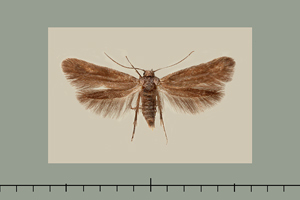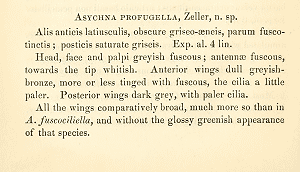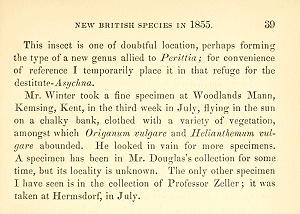

 +15Kontinente:EU
+15Kontinente:EU2. Diagnose
2.1. Weibchen
2.2. Ähnliche Arten
- Epermenia devotella (Heyden, 1863)
- Phaulernis statariella (Heyden, 1863)
- Epermenia pumila (Buvat & Nel, 2000)
2.3. Erstbeschreibung
3. Biologie
3.1. Nahrung der Raupe
- [Apiaceae:] Pimpinella saxifraga (Kleine Bibernelle)
- [Apiaceae:] Aegopodium podagraria ?? (Giersch, Geißfuß ??)
- [Apiaceae:] Angelica sylvestris ?? (Wald-Engelwurz ??)
- [Apiaceae:] Daucus carota ?? (Wilde Möhre ??)
Bei Schütze (1991) ist zu lesen: "In den Samen von Pimpinella saxifraga, Aegopodium, Angelica (Sorhagen)."
Godfray & Sterling (1996) schreiben: "Ovum. Laid on wild carrot (Daucus carota), burnet-saxifrage (Pimpinella saxifraga), wild angelica (Angelica sylvestris) or ground-elder (Aegopodium podagraria), probably on thee seeds." Nach ihren Ausführungen scheint davon Pimpinella saxifraga jedenfalls die wichtigste (und einzige?) Raupennahrungspflanze der Art in Großbritannien zu sein.
Auf [Artdatabanken.se] ist zu erfahren, dass die Raupe in Schweden an Pimpinella saxifraga zu finden ist, von mitteleuropäischen Autoren aber auch von Aegopodium und Angelica gemeldet wird.
Budashkin & Gaedike (2005) fassen zusammen: "Larvae in seeds of Pimpinella saxifraga and other species of this genus." Sie stellen also die Angaben zu Aegopodium, Angelica und Daucus carota unausgesprochen in Frage.
4. Weitere Informationen
4.1. Andere Kombinationen
- Asychna profugella Stainton, 1856 [Originalkombination]
4.2. Taxonomie
Huemer & van Nieukerken (2021) synonymisierten Epermenia pumila mit E. profugella und erläuterten: "Epermenia pumila was described from a male specimen collected in 1948 in the Alpes-Maritimes (Buvat & Nel 2000). We have not been able to examine the holotype, but examined a second specimen identified as E. pumila by J. Nel which fully corresponds to the original description. This specimen agrees both morphologically and in the DNA barcode with E. profugella (Stainton, 1856) and E. pumila is therefore synonymized with that species." Nel & Varenne (2024: 105) widersprachen dem mit einer überraschenden Begründung: "Ce taxon a été décrit dans le genre Cataplectica caractérisé par un tegumen court, genre actuellement incorporé dans celui des Epermenia. Toutes les espèces connues de France du sous-genre Cataplectica sont plus ou moins brun uniforme à l’exception de C. pumila qui présente un habitus très clair et orné, non uniforme (fig. 4). C. pumila a été mis en synonymie par Huemer & Nieukerken, 2021 avec C. profugella espèce brun uniforme, à la suite d’une erreur d’étiquetage de l’exemplaire barcodé, erreur due à l’un d’entre nous (J.N.). Les figures des genitalia (fig. 5) présentent ici les principaux caractères distinctifs entre les trois espèces françaises connues, en accord avec la description originale de C. pumila (Buvat & Nel, 2000). Sur cette base, nous restaurons son statut de bona species."
Achtung: ["E. pumilia" bei BOLD Systems] gehört demnach nicht zu E. pumilia sondern zu E. profugella!
(Autor: Erwin Rennwald)
4.3. Literatur
- Budashkin, Y.I. & R. Gaedike (2005): Faunistics of the Epermeniidae from the former USSR (Epermeniidae). — Nota lepid. 28 (2): 123–138. [PDF auf soceurlep.eu]
- Beschreibung als Cataplectica pumila: Buvat, R. & J. Nel (2000): Trois Microlépidoptéres nouveaux ou méconnus de la faune de France (Lepidoptera Gelechiidae, Stathmopodidae et Epermeniidae). — Alexanor 21 (1-2): 95-99.
- Godfray, C.C.J. & P.H. Sterling (1996): Epermeniidae. - S. 115-123. In: Emmet, A.M. [Hrsg.](1996): The moths and butterflies of Great Britain and Ireland. Volume 3. Yponomeutidae - Elachistidae. - 452 S.; Colchester, Essex.
- Huemer, P. & E. van Nieukerken (2021): Identity of some recently described Lepidoptera from France — re-assessed with DNA barcodes and morphology. — Zootaxa 4941 (3): 301–337. [zum open-access-Artikel und PDF-download auf mapress.com]
- SCHÜTZE (1931): 146
- Erstbeschreibung: Stainton, H. T. (1856): Lepidoptera. New British Species in 1855. — The Entomologist's Annual for MDCCCLVI: 26-45 + frontispiece. London (John van Voorst).




















